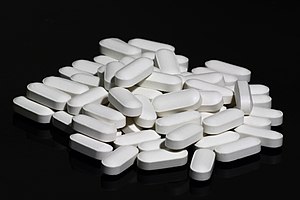カルシウムサプリメント
Calcium supplement/ja
 炭酸カルシウムから作られた500mgのカルシウムサプリメント | |
| Clinical data | |
|---|---|
| Trade names | Alka-Mints, Calcet, Tums, others |
| AHFS/Drugs.com | Monograph |
| License data | |
| Pregnancy category |
|
| Routes of administration | by mouth, intravenous |
| ATC code | |
| Identifiers | |
| CAS Number | |
| ChemSpider |
|
| UNII | |
カルシウムサプリメントは、多くの症状で使用されるカルシウムの塩である。サプリメントは一般に、食事中のカルシウムが十分でない場合にのみ必要とされる。経口では、低血中カルシウム、骨粗鬆症、くる病の治療および予防に用いられる。静脈内注射では、筋痙攣を引き起こしている低血中カルシウムや、高血中カリウムまたはマグネシウム中毒に用いられる。
一般的な副作用は便秘と吐き気である。経口摂取による高血中カルシウムはまれである。カルシウム補助食品は、食事由来のカルシウムとは異なり、腎結石のリスクを高めるようである。一般に成人は、1日に約1グラムのカルシウムを必要とする。カルシウムは骨、筋肉、神経にとって特に重要である。
カルシウムサプリメントの医薬品としての利用は19世紀に始まった。世界保健機関の必須医薬品リストに掲載されている。ジェネリック医薬品としても販売されている。2020年には、米国で204番目に多く処方された医薬品であり、2 万以上の処方があった。また、ビタミンDと一緒に販売されているものもある。2020年、カルシウム/ビタミンDの組み合わせは、米国で215番目によく処方される医薬品であり、2 万処方以上であった。
健康への影響=
骨の健康
健康な人では、カルシウムのサプリメント摂取は骨密度の維持には必要ではなく、有益性を上回るリスクがある。 カルシウムの摂取量は、男性でも女性でも股関節骨折のリスクとは有意に関連していない。 U.S. Preventive Service Task Forceは、カルシウムまたはビタミンDの毎日の補給を推奨していない。 2006年のレビューによると、健康な小児ではカルシウムの補充により骨密度がわずかに増加したが、食事性カルシウムの追加摂取は正当化されない。
心血管系への影響
1日1,000~1,500mgのカルシウム補給が、血圧の病態を持たない成人において、血圧の緩やかな低下をもたらすという十分な証拠があり、十分なカルシウム濃度を達成することが高血圧の予防に役立つ可能性が示唆されている。
がん
米国国立がん研究所は、がんのリスクを低下させるためのカルシウムサプリメントの使用を推奨していない。カルシウム補給が大腸腺腫性ポリープの発症予防に効果があるかもしれないという弱い証拠はあるが、そのような補給を推奨するには十分な証拠ではない。
副作用
炭酸カルシウムの制酸剤/栄養補助食品(タムズなど)を数週間または数ヵ月にわたって過剰に摂取すると、高カルシウム血症から致命的な腎不全に至る症状を呈するミルク-アルカリ症候群を引き起こすことがある。 何をもって"過剰"摂取とするかはよくわかっておらず、個人差が大きいと推測される。 10 グラム/日以上のCaCO3(=4gのCa)を摂取している人はミルクアルカリ症候群を発症する危険性があるが、少なくとも1人の人が2.5 グラム/日のCaCO3(=1gのCa)しか摂取していないことが報告されている。
2023年のシステマティックレビューによると、カルシウム補給は心筋梗塞、脳卒中、心不全入院、心血管/全死因死亡率とは関連がない。
カルシウムのサプリメントは、腎臓結石の発生を助長する可能性がある。
Acute calcium poisoning is rare, and difficult to achieve without administering calcium intravenously. For example, the oral median lethal dose (LD50) for rats for calcium carbonate and calcium chloride are 6.45 and 1.4 g/kg, respectively.
Interactions
Calcium supplements by mouth diminish the absorption of thyroxine when taken within four to six hours of each other. Thus, people taking both calcium and thyroxine run the risk of inadequate thyroid hormone replacement and thence hypothyroidism if they take them simultaneously or near-simultaneously.
Types
The intravenous formulations of calcium include calcium chloride and calcium gluconate. The forms that are taken by mouth include calcium acetate, calcium carbonate, calcium citrate, calcium gluconate, calcium lactate, and calcium phosphate.
- The absorption of calcium from most food and commonly used dietary supplements is very similar. This is contrary to what many calcium supplement manufacturers claim in their promotional materials.
- Different kinds of juices boosted with calcium are widely available.
- Calcium carbonate is the most common and least expensive calcium supplement. It should be taken with food, and depends on low pH levels (acidic) for proper absorption in the intestine. Some studies suggests that the absorption of calcium from calcium carbonate is similar to the absorption of calcium from milk.
- Antacids frequently contain calcium carbonate, and are a commonly used, inexpensive calcium supplement.
- Coral calcium is a salt of calcium derived from fossilized coral reefs. Coral calcium is composed of calcium carbonate and trace minerals. Claims for health benefits unique to coral calcium have been discredited.
- Calcium citrate can be taken without food and is the supplement of choice for individuals with achlorhydria or who are taking histamine-2 blockers or proton-pump inhibitors. Calcium citrate is about 21% elemental calcium. One thousand mg will provide 210 mg of calcium. It is more expensive than calcium carbonate and more of it must be taken to get the same amount of calcium.
- Calcium phosphate costs more than calcium carbonate, but less than calcium citrate. microcrystalline hydroxyapatite (MH) is one of several forms of calcium phosphate used as a dietary supplement. Hydroxyapatite is about 40% calcium.
- Calcium lactate has similar absorption as calcium carbonate, but is more expensive. Calcium lactate and calcium gluconate are less concentrated forms of calcium and are not practical oral supplements.
Vitamin D is added to some calcium supplements. Proper vitamin D status is important because vitamin D is converted to a hormone in the body, which then induces the synthesis of intestinal proteins responsible for calcium absorption.
Labeling
For U.S. dietary supplement and food labeling purposes, the amount in a serving is expressed in milligrams and as a percent of Daily Value (%DV). The weight is for the calcium part of the compound – for example, calcium citrate – in the supplement. For calcium labeling purposes 100% of the Daily Value was 1000 mg, but in May 2016 it was revised to 1000–1300 mg. A table of the pre-change adult Daily Values and references for the revision are provided at Reference Daily Intake. Food and supplement companies had until July 2018 to comply with the labeling change.
外部リンク
- "Calcium". Drug Information Portal. U.S. National Library of Medicine.
- "Calcium carbonate". Drug Information Portal. U.S. National Library of Medicine.
- "Calcium lactate". Drug Information Portal. U.S. National Library of Medicine.